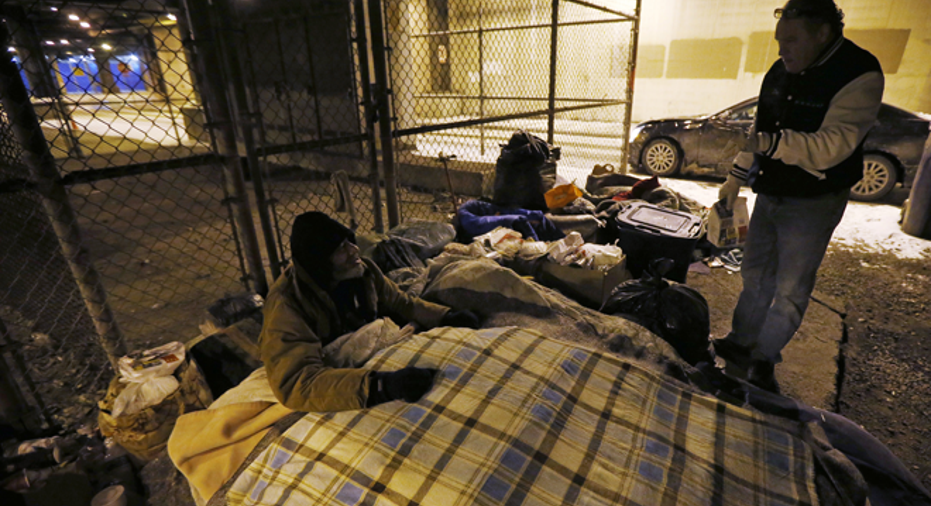How Housing for the Chronically Homeless May Save Taxpayers Money

Four years ago, an initiative called 100,000 Homes was launched by the non-profit Community Solutions with the aim of placing 100,000 chronically homeless people in permanent housing. The deadline was July 2014 -- and today, the movement has surpassed its goal and says this milestone is saving taxpayers an estimated $1.3 billion annually across 238 U.S. communities.
“It’s significantly cheaper to house this group of people than leave them alone on the streets,” explained Jake Maguire, director of communications for the 100,000 Homes Campaign. “We’ve found that chronically homeless people, who are about 12% of the homeless population, make up 80% of the total government costs spent, from emergency room visits to jail time…. We are wasting a huge amount of money in this country keeping these people homeless.”
It’s important to differentiate between the types of homelessness. According to the U.S. Department of Housing and Urban Development, as of January 2013, there were approximately 610,000 people sleeping on America’s streets on any given night. In the last estimate, there were 92,000 chronically homeless, who are homeless for more than a year or homeless four or more times in the last three years and are considered to be the most vulnerable.
“We’ve found that chronically homeless people, who are about 12% of the homeless population, make up 80% of the total government costs spent, from emergency room visits to jail time…. We are wasting a huge amount of money in this country keeping these people homeless,”
A cost-savings assessment, conducted by Liana Downey and Associates, a strategic advisory firm to 100K Homes, found that while some costs go up when permanent housing is found for the chronically homeless, they are outweighed by the costs that decline. For example, while payments to the Department of Social Services rose an average of $3,800 a year, in-patient hospital costs declined by an average of $8,000 per person.
The savings appear to be real, so much so that investors are buying into the idea.
Denver, Colorado, believes so strongly in ending the perpetual cycle of the chronically homeless bouncing between the streets and emergency rooms that in June the city announced a new $8 million program aimed at helping this group that is being funded in an unusual way. Investors provide the funding through “social impact bonds” and are paid back, with interest, if the effort saves the city money elsewhere.
The $1.3 billion savings that the 100K Homes study revealed certainly sounds like a lot of money, but as Liana Downey, the head of the firm pointed out, when it’s broken down, that number equates to an average savings of $13,000 per person housed.
“We’re not saying the government will save $13,000 on any homeless person, but we are saying it will save roughly this amount on a chronically homeless person -- and we kept that estimate conservative,” explained strategic advisor Liana Downey.
So far, 100K Homes has secured permanent housing for 101,628 chronically homeless people, including 31,171 homeless veterans.
A key component of the 100K Homes program is that all people in permanent supportive housing pay 30% of their income toward rent, which Maguire said mostly comes from Social Security, disability, veterans benefits, or some kind of work income. If their income grows, the 30% grows with it in dollar terms. Depending on the community, the campaign works with other local non-profits and government departments, using government resources that have already been allocated to the homeless. But, as Maguire pointed out, they are using the resources more effectively.
“This is an example I often use when I explain [the rationale behind] helping the chronically homeless: If a person with a broken arm walks into a hospital and five minutes later a man who is having a heart attack comes in, who do you treat first? Obviously, the man with the heart attack,” said Maguire. “It’s not who comes first. But right now, we are giving housing first come, first serve, and it’s not working because the people who really need it aren’t getting these services.”
Another notable statistic is that, according to the latest 100K Homes figures, 84% of those housed do not become homeless again.
“We need to start thinking differently. We need to focus on the complicated and worst-off group [of homeless] instead of brushing it aside and saying ‘That’s too complicated to solve. Let’s focus on the easier group’ because that doesn’t solve the problem,” Downey said. “We need different agencies to all work together to solve the hard problems and allocate resources, and once we prioritize differently and focus on the chronically homeless who are driving up the costs so significantly, we will be able to free up money and can better serve every homeless person.”